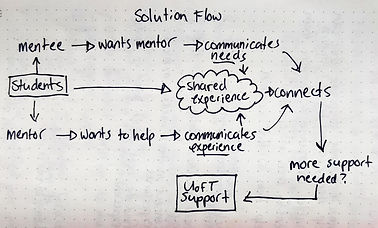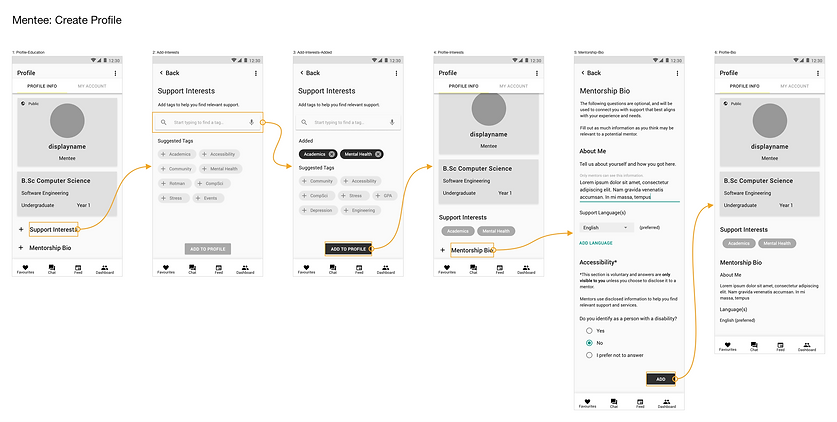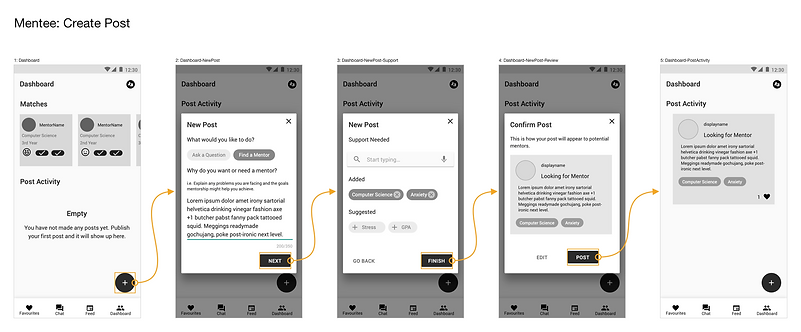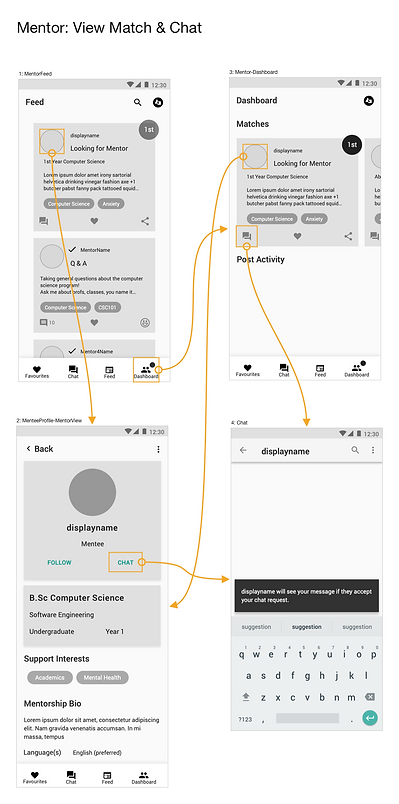Peer Mentoring and Mental Health
Google Design Exercise (2020)
The Problem
Your school wants to strengthen the community by encouraging experienced students to connect with new students and help them adjust to campus life. Design an experience that allows mentors and mentees to discover each other. Consider the needs of both mentors and mentees, including how someone may become a mentor and how to connect mentors to mentees.
The University of Toronto (UofT) is in need of a mentorship program that accounts for student mental health. In recent years, rates of suicide among students have risen- and the university is struggling to accommodate the thousands of students who need help. Though new mental health initiatives have been developed, students- and the public- are putting pressure on UofT to take accountability for student wellness needs.
I wanted to create a solution that allows mentors and mentees with similar lived experience to find each other and enable difficult discussions about mental health. By allowing students to seek support and guidance from experienced students, this solution aims to improve overall student well-being as well as ease the burden on UofT’s overrun support services.
Research & Discovery
To better understand how I might solve this problem, I outlined a few research questions:
-
How is mentorship and mental health currently addressed at UofT?
-
Why would someone seek mentorship? Why would someone become a mentor?
-
How could this provide value back into the community?
To try to answer my questions, I talked to a UofT Social worker/former student and two current students to understand how they see mentorship. Additionally, I conducted secondary research on how mentorship and mental health are currently addressed at UofT.
Key Takeaways to Consider:
-
Peer mentorship is more effective when people share lived experience
-
i.e. People struggling with depression are more likely to open up to peers who have also experienced depression.
-
-
Mentorship programs are perceived to be a lot of work for the mentor
-
People in social work or psychology may become a peer mentor because their degree requires some kind of leadership or mentorship experience
-
Students may become a mentor for resume experience or a reference
-
Interaction between first year students and upperclassmen is limited
-
People may reach out to a mentor with specific questions or general advice
-
Feelings of support from 1st to Senior year dropped from 30.1% to 24.9 %
Job Stories
To help me focus in my target audience, I utilized "Job Stories" aka a "Jobs to be Done" framework.
Mentee Job Story
When I need to feel supported at school but my problems aren’t serious enough to bother a support staff member
I want to talk to someone casually that will understand my troubles
So that I can get some reassurance and relief
-
Motivations:
-
I want to get relevant help and advice
-
Feel comfortable sharing without added pressures
-
I want to overcome the bad stuff
-
-
Anxieties:
-
I don’t want to waste anyone’s time
-
There’s people with more serious issues than me
-
I don’t want to be judged or ridiculed
-
Mentor Job Story
When I am on track to graduate and need additional experience to make me more employable
I want to do as little as possible because my schedule is already packed
So that I can graduate on time with relevant experience
-
Motivations:
-
I want something good to put on my resume
-
I want to make an impact without much work
-
-
Anxieties:
-
I don’t know what I can do with the experience I have
-
I might not have time to handle a big commitment
-
This framework is a personal favourite of mine, as I find it really allows me to understand how a user may achieve a job to be done despite a lack of time for data collection.
Target Audience and Stakeholders
From the Job Stories exercise, I was able to generate a general understanding of my target audience and their needs i should be considering.
Mentees
New or Returning Students who need mental health or general support mentorship
Mentors:
Upper year students who need resume experience on a minimum time commitment
UofT Support Workers
They need to ease the burden on services while still providing support
Though I did not design for UofT support workers in this iteration, I wanted to ensure they remained in the back of my mind during my design process as relevant stakeholders.
High-Level Goals
After getting a better sense of my audience, broke down the many needs of my users into overarching, digestible goals for my system to keep in mind:
-
Connect users to each other
-
Help users control private information
-
Easily communicate needs and experience
-
Help users find/give support
-
Provide value
Asking Questions, Ideating Solutions
To come up with some solutions and ideas for the needs I had defined, I asked questions with a "How Might We" exercise, and proceeded to ideate answers for those questions.

Though it doesn't show in the above iteration of my diagram, I found many of my solutions overlapped with each other.
Some Question and Answer highlights:
-
HMW maximize support with a minimum time commitment?
-
Multiple mentors per mentee
-
Mentorship group chat
-
-
HMW ensure mentees feel comfortable and supported?
-
Privacy hierarchy (for sensitive information)
-
Multiple mentors per mentee
-
-
HMW help mentees communicate their needs/help mentors communicate their experience?
-
'Areas of improvement' categories on profile
-
Privacy hierarchy (for sensitive information)
-
-
HMW find the best mentor/mentee match?
-
Compare life stories
-
Different mentor types
-
'Areas of improvement' categories on profile
-
Considering Solutions
Mapping the Ecosystem
To help me conceptualize how a solution may work, I created some flow charts including my target audience and stakeholders.

This chart (above) envisioned how the target audience and stakeholders may fit into a solution on a higher level with little detail.

This flowchart reflected an end-to-end journey of my potential solution, considering a wider support ecosystem.
I find this step helps me conceptualize specific design elements within a wider framework- as I want to be able to justify all aspects of my design as serving a broader purpose for future growth.
Remaining Questions & Assumptions
Despite my best efforts to consider how a solution may be implemented, I still had some questions.
Given more research time, these would be the questions I might answer through talking to users. However, I was on a bit of a time crunch- so I made some assumptions based on my knowledge and experience.
Privacy considerations should be made, should all users see the same information?
-
I felt that given the nature of some users' potential support concerns, giving the users the option to disclose information to potential mentors was ideal rather than make sweeping privacy judgements.
Will there be a higher mentee to mentor ratio?
-
Likely yes, considering the time commitment needed from upper year students.
How important is the one-on-one relationship to mentees?
-
This would depend on the issue and mentee- though I assumed mentees might just need a mentor to answer a specific question once in a while rather than have continuous, in-depth conversations.
What level of responsibility would most mentors be comfortable with?
-
I think this once again might depend on the mentor, and even then be subject to change depending on the time of year, assignments, and personal lives.
Will mentees be more open to sharing their lived experience if they see mentors doing so?
-
I assume that if mentors lead by example and create a welcoming environment, mentees may be more likely to share their lived experience, which will help them find mentors that can best help them.
Designing Solutions
Turning Goals into Features
At this point, I revisited my high-level goals and considered their implementation, and developed actionable objectives my system should satisfy to create a meaningful solution.
-
Connect users with relevant goals
-
Allow users to share sensitive information if they wish with controlled privacy
-
Enable users to communicate their support interests easily (both mentors and mentees)
-
Allow mentors to provide varying levels of support
-
Help users find each other to receive/provide relevant support
With this in mind, I focused in on how my objectives could be reached through an app design.
User Profiles
-
Users should be able to remain anonymous so they feel more comfortable sharing their support needs.
-
To help matching users find each other, they need to be able to show it on their profile in an easily accessible format.
-
Profiles should allow users to change their details to better reflect their current needs and experience.
Mentor Posts
-
Mentors should be able to broadcast their knowledge and experience to mentees, even if they’re not their personal mentor.
-
To help encourage community, mentor posts should allow users to follow-up or add to the discussion. This allows mentees who might not have a one-on-one relationship with a mentor to still feel supported and heard.
-
Users should be able to keep up with a specific mentors’ posts, especially if they’re relevant to their needs.
Mentee Posts
-
Mentees should be able to broadcast their needs to reach potential mentors
-
Sometimes mentees want a fully-fledged mentor, and sometimes they may have general questions they want answered, and this should be accounted for.
-
Mentors should be able to share mentee posts if they know of someone who can help them.
Activity Updates
-
Users should be able to see any activity on their posts so they can respond accordingly or track their visibility.
-
Users should be presented with potential mentor/mentee matches as they come up- especially if they’re a perfect match.
-
Users should have a place to see the content of mentors they connect with
Support tagging
-
The subject matter of posts and mentor/mentee support interests should be clearly communicated.
-
Mentors making posts should be able to assign it a subject matter/area of support so users can find it.
-
User profiles should be easily found by their support interests.
-
If a post or profile is unrelated to a user’s support interests, this should be visible as well.
Chat/Communication
-
After users go through the process of finding each other, they should be able to initiate a private chat.
-
Chat should require an invitation/acceptance to initiate to prevent mentors from getting bombarded with messages
-
Chat functionality should be kept simple and focused- the primary purpose is to facilitate a connection
Sketching Designs
With an idea of what sort of features I wanted to include, I began to sketch some flows and key features I had in mind.
Some of the things I included in my sketches didn't make the cut to the digital mockups, as sketching gave me clarity on the features and flows I was considering. Some of my considerations are seen as notes on my sketches, highlighting my thought process through my iterations.

Reworking Navigation
While sketching I was having trouble with the navigation structure of my solution. Because it involved multiple layers of information on both the mentor and mentee side, I wanted to simplify the already complex design by streamlining my information hierarchy.
So, I turned to a mind map to make sure my information hierarchy made sense.

With the mind map, I was able to prioritize information onto 5 global navigation links.
WIth such a complex design, it was important for me to make the navigation structure simple, as well as visible. I felt that hiding navigation elements in a drawer might present a significant barrier to entry, especially for users that might be feeling overwhelmed.


Low-Fidelity Designs
After sketching, I moved onto prototyping with Sketch.
I started with a low fidelity prototype, to test layout and flows. With the prototype, I wanted to show the flow of a user creating their profile, as the profile is a critical feature that enables users to express their support interests.

Support Tags
Through profile creation, users are immediately introduced to the concept of support tags. Support tags are general topics or areas of concerns that users may want to work on. Using a tagging function was important for me as if this was implemented realistically, it would be the easiest way to develop a system-wide language for search and filtering.
Mentorship Bio
To account for some of my identified concerns with privacy and disclosure of information, I included a profile feature- the Mentorship Bio. This was included to give users a way to disclose any accessibility concerns or diagnoses to other users if they wish. In the mentorship bio is a questionnaire regarding disclosure of accessibility concerns. This was included to allow a user to self-identify with a disability, helping them find mentors who may have the same experiences with accessibility at school.
Mentee Dashboard
After users finish setting up their profile, they are immediately introduced to their dashboard which shows potential user matches. (The matches cards for mentees changed a lot from what is shown below in the high-fidelity prototype) As facilitating connection between mentors and mentees is the central purpose of this app, having the dashboard as the first page users see after setup is crucial.

Mentee Posts
This flow outlines how a user may request a mentor, in a sort of Classifieds style posting. The option to simply ask a question is also available, as it provides mentors with a chance to help someone without necessarily becoming their one-on-one mentor.
Features:
-
Add support tags
-
Adding new tags is particularly useful if a user is asking a question, as they may have a question unrelated to their general support interests.
-
Mentor Profile
This flow shows one way in which a user might find a mentor's profile.
This way in particular shows how a user may find something that interests them on their feed, and proceed to look up the post's author to see if their interests align.
Features:
-
Follow
-
This allows mentees to see mentor posts without necessarily having to chat with them one-on-one.
-
Especially for mentees struggling with mental health issues, the ability to receive guidance without asking for it directly was a critical function I wanted to include.
-
-
Chat
-
This allows users to sent mentors a chat request. As mentors will be in high demand, having a request sent first allows mentors to screen their requests.
-

Post Types
As mentee and mentor posts are functionally different, mentors are given slightly different options when presented with a mentee's post. However, both types of posts share some commonalities
Features of both types of posts:
-
Favourite button
-
allows users to favourite posts for later. This feature was included particularly for mentees to save any support posts so they can revisit them later.
-
-
Support tags
-
To show what the post is related to
-
-
"1st" Badge
-
Easily shows users what posts align with a user's support interests
-



Mentee Post Features:
-
Chat
-
This allows mentors to contact mentees right away when they see their post.
-
-
Share
-
This allows mentors to share posts amongst themselves through chat, as they might know of someone who can better help a mentee.
-
Mentor Post features:
-
Comment
-
This enables mentees to comment on a mentor's post to enter a discussion of the topic, share their experience, or engage with the mentor further.
-
-
Rating
-
This shows how the mentor has been rated through the use of emoticons. People can rate mentor's posts on the post page (not shown for scope), or after receiving mentorship one-on-one.
-
High-Fidelity Designs

With the details of my design fleshed out, I moved on to creating high fidelity designs.
This process mostly involved tweaking the existing design to be more uniform and aesthetically pleasing, and finally coming up with an overall look and feel.
To ensure continuity, I worked with material design in both my low and high fidelity designs.
Aesthetics
With this design I tackled a difficult subject matter- student mental health. Keeping that in mind, I wanted to keep my design bright and uplifting. A recurring theme in my sketches was the use of a sun to depict the importance of a match, I decided to run with a visual theme representing a sunny sky.
With such a contrasting colour scheme, I kept the majority of elements blue and white, and used yellow highlights to draw the user's eye to important information, such as mentee profiles, matched support tags, and action buttons.
Additionally, this colour scheme was considered to account for colour blindness, as blue and yellow remain a fairly safe pick for varying degrees of visual impairment.

High-Fidelity Iteration

Before

After

Before

After
My high fidelity prototype went through some changes before I was satisfied with the design. My initial design had outlined profile cards and buttons with a thick gradient border, however I felt it might have looked a bit 'busy', and made some of the text difficult to read.
My final design uses thinner borders and soft gradient fills to make posts stand out from the background.
Final Thoughts
Upon receiving the design brief for this project, I immediately wanted to apply the scenario to a real issue at my school: student mental health. I knew from the beginning this was not the easy route, as connecting students with each other while considering their mental health is a multifaceted challenge with a potential for major impact on a school community.
My design focused on questioning what traditional mentorship looks like, and presenting a modern solution for schools trying, and failing, to provide adequate support services. I wanted to challenge the notion of mentorship as a formalized process by giving students various methods to express their knowledge and life experience. I believe that through the expression of life experience, students can develop real empathy for each other and realize the struggles many students face- but don’t talk about.
Future Steps
My design is not perfect, and I think with additional time and research it could be improved upon. Some future areas I would focus on are:
-
Testing the use of various app features, such as mentor rating, and determine their usefulness.
-
This for me is a no-brainer, as designing the navigational structure for so many components was quite difficult. By conducting further research on the app's features, various elements can be improved upon or redesigned to increase their usefulness.
-
-
Talk to students struggling with mental health issues and design more for their needs.
-
While I made a conscious effort to draw upon my lived experience with mental health struggles, the conversation I had with a social worker, and my secondary research on the topic, it was nowhere near enough to capture the needs of students today.
-
-
Consult a psychologist and student support workers to get their opinion on how effective this app could be.
-
Once again, additional research or an extra opinion would help this app provide much more value to its users.
-
Additionally, given the recent research on social media's impact on mental health, an expert opinion on the social media-esque features of this design would give additional clarity on its effectiveness.
-
-
Determine alternatives for features traditionally seen in social media
-
As my design focused on students' ability to share their lived experience to find a mentor, I included some elements traditionally seen in social media to enable users to favourite and comment/engage in discussion on posts. I would ideally like to conduct additional research on alternatives to these functions, as I want to avoid using elements that may exacerbate any negative behaviours.
-
My design focused on questioning what traditional mentorship looks like, and presenting a modern solution for schools trying, and failing, to provide adequate support services. I wanted to challenge the notion of mentorship as a formalized process by giving students various methods to express their knowledge and life experience. I believe that through the expression of life experience and peer mentorship, students can learn essential lessons on mental health, academics, and life balance. With the development of such a platform, educational institutions can begin to recognize the struggles many students face- but don’t talk about.
